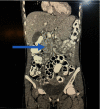An Atypical Presentation of Childhood Paraganglioma with Seizures: A Case Report and Review of the Literature
- PMID: 38058957
- PMCID: PMC10696474
- DOI: 10.1155/2023/6637802
An Atypical Presentation of Childhood Paraganglioma with Seizures: A Case Report and Review of the Literature
Abstract
Introduction: A paraganglioma (PGL) is a tumour derived from extra-adrenal chromaffin cells of the sympathetic paravertebral ganglia of the thorax, abdomen, and pelvis. Cardiovascular manifestations predominate but neurological symptoms like seizures can occur requiring a high index of suspicion for prompt diagnosis and treatment. Case Description. A 14-year-old girl was referred to the paediatric neurology unit for recurrent headaches of one-year duration, vomiting of 2 months duration, and an episode of generalized tonic-clonic seizures, 2 weeks prior to presentation. There was an associated history of impaired vision, palpitations, diaphoresis, and easy fatigability. Her blood pressure ranged from 150/101 to 160/120 mmHg. The brain CT scan was normal. ECG showed left ventricular hypertrophy. Abdominal USS revealed a right para-aortic mass necessitating 24-hour urine normetanephrine which was markedly elevated-1695.34 mcg/24 h (100-500). An abdominal CT scan confirmed a paraganglioma in the right para-aortic region. A multidisciplinary team consisting of paediatric endocrinologists, radiologists, anaesthetists, paediatric and cardiothoracic surgeons, and the intensive care unit (ICU) team was involved in the peri and postoperative management of the child. Intraoperative challenges were hypertension and hypotension (following tumour excision). She was nursed in the ICU for 48 hours. Histology results confirmed paraganglioma. Postoperative urine normetanephrines done a month after surgery had reverted to normal. Her blood pressure has remained normal 6 months after surgery, and no other symptoms have recurred.
Conclusion: In evaluating aetiology of childhood hypertension, endocrine causes must be considered though they are rare. The occurrence of paraganglioma is uncommon and can present in unusual ways such as seizures. Measurement of blood pressure in children is advocated as part of routine health care. Clinicians must explore the aetiology of seizures and not merely control them with anticonvulsant therapy.
Copyright © 2023 Elizabeth Eberechi Oyenusi et al.
Conflict of interest statement
The authors declare that they have no conflicts of interest.
Figures



References
Publication types
LinkOut - more resources
Full Text Sources

